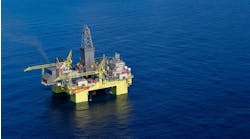Offshore staff
TUNIS, Tunisia -- ADX Energy has confirmed discovery of hydrocarbon-bearing zones in the Lambouka–1 well offshore Tunisia.
Drilling and wire line logging operations have finished, with the well at a total measured depth of 2,786 m (9,140 ft). Analysis of the final suite of wire line logs supports earlier results from logging while drilling.
ADX says at least two hydrocarbon-bearing zones are present in the Abiod formation, which was the well’s primary objective. These are thought to comprise gas and possibly condensate in the lower interval, based on hydrocarbon shows recorded from the cuttings during drilling and the results of gas chromatography.
For technical reasons the gas shows were not as strong as those encountered in the same Abiod interval in the nearby Dougga 1 discovery. However, no carbon dioxide (CO2) was detected while drilling the Abiod formation, as was the case with Dougga 1.
ADX has interpreted net pay of around 23 m (75 ft) in the two Lambouka reservoir units. This, it claims, compares favorably with Dougga, which has an estimated net pay of 14 m (46 ft) in the Abiod and mean resources of 74 MMboe.
In addition, wire line analysis suggests the first interpreted water-bearing reservoir was encountered around 230 m (754 ft) below the upper hydrocarbon zone. Wire line logs and drilling data indicate that the Abiod limestone formations at Lambouka–1 are heavily fractured, which is a good sign for reservoir productivity.
However, drilling fluid losses and increasing well bore deterioration have hampered recovery of fluid samples and pressure data measurement from the Abiod formation.
ADX adds that operations in the existing well bore have become increasingly difficult, and the productivity of the reservoir from this well bore may well have been affected, making it difficult to obtain representative flow rates from a drillstem test.
The company and its partners are considering whether to suspend or P&A the well. This depends on whether suspension and a future re-entry would provide the best means to minimize rig time and maximize reservoir information acquired from a drillstem test of the Abiod formation.
A future borehole trajectory for the lower section of the well also could serve to test the up dip potential of the structure, along with the porous sandstones encountered farther down that are interpreted to be in closure at an up dip location.
Further interpretation of 3D seismic suggests up dip potential from the crest of the structure to the Lambouka 1 well location of roughly 250 m (820 ft).
09/07/2010


